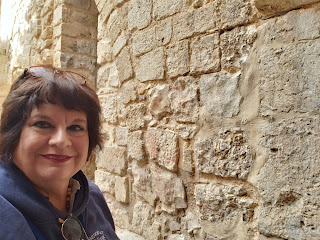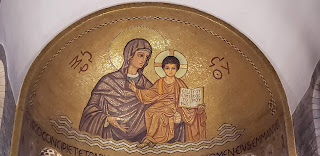I have to say, it really IS beautiful, even though, because of the salt content, no life can survive in it.
 |
| SUNRISE |
It is mysterious in its quiet, alive in its lifelessness. It is 1,412 feet below sea level, the lowest point on the earth.
I spent several days around it, near it, and about 20 minutes in it, floating on the salt water and coming out soft, full of its natural spa minerals.
So, what is around the Dead Sea? Magnificent things. Among them, Qumran, where the Dead Sea Scrolls were found. Discovered by a Shepherd in the late 1940s, the Scrolls are religious and non-religious writings from the periods between the third century before Christ through to approximately the period of the destruction of the Second Temple in 70 A.D. They were on parchment, and contained in jars in caves. They are carefully preserved in a nearby museum. (I had the good fortune to see an exhibit many years ago in San Diego, but nothing matches seeing the place where they were found).
 |
| Replicas of the Jars in which the scrolls were found |
I admit to a partiality when it came to this part of the trip. I have been long fascinated with one particular place, an impossible mountain upon which a group of Jews lived and died at the hands of the Roman Legion sent to crush them just a few years after the destruction of the Second Temple. Masada. This fascination rivaled the one I used to have about Pompeii, and I suppose, I still have about Pompeii. They are in a way the same fascination. These places, frozen in time, are a connection from now, to then. It is as if there one can be physically introduced to people long gone. You can almost touch their very feelings as if they still hover in the air, in the decaying but still standing buildings. I knew of Pompeii from a child's book, something called "The All About. . . " series. But Masada I learned of much later, in the early 1980s, when it was the subject of a partially fictionalized movie starring Peter O'Toole (a big and continued favorite) and Peter Strauss. The basic story was that of history, though the exact numbers of Jews and whether they were a certain sect of zealots and the time frames involved and some of the specific events are disputed: Masada had been in the time of Herod the Great a place of pleasure resort, the site of a three tiered palace so far above the earth as to be a glimpse of heaven. Herod the Great was the father of the Herod that gave Jesus so much grief (Herod Antipas). Herod the Great had been a great architect. Even though it is a skeleton of its former glory, one cannot miss that this palace had been magnificent. But by the time of the destruction of the Second Temple, it had become a refuge for about 1000 Jews who would not submit to Rome. They included families with their leaders, particularly Eleazer Ben Yair. The large space had room for storing grain and had deep and large cisterns for water and a system to move the water. There was a trail, known then, and now, as the Snake Trail, steep and exhausting, through which they could lead animals and household needs.
The Roman Legion, headed by Flavius Silva, could not easily reach these people to subjugate or kill them. It was just so high up and so unapproachable without being hit with stones or other implements from above.
And so, the resourceful Silva had ramps built to the walls and brought up a battering ram, and set fire to the wooden walls that covered the mountain stone. Before the breach, the Jews had to decide, wait and be killed, enslaved, or have their women raped and killed or enslaved, or die by their own hands.
They chose suicide. When Silva entered hoping for victory, he found all of them dead.
Over time, Masada became a symbol, of persistence, liberty, of the resolve of the Jewish people to remain in their Biblical home. "Masada shall not fall again!". New Israeli recruits are sworn in on the mountain.
It is an awesome place.
Since no one would prevent it today, one can still take the Snake Trail, but if so, it must be done early in the morning and one's health better be pristine. Even in late November, the sun is hot. Our group, of mostly the middle aged and older, took the funicular. This was, for me, a bit of a moment of courage. Not only do I hate to fly, but I hate things that move on wires, however strong, up large mountains. The last time I did that was to Mt. Jacinto in Palm Sprints, and I was terrified then. But my eagerness to be at the top of Masada overshadowed my fear, and I stepped into the 80 person (yes) machinery to take us to the top.
 |
| Going up, or going down, not sure which. |
The thing about these places we visited, nearly all of them, really, is that human beings could live, and thrive in these deserts in those times, when NONE of the conveniences to which we are accustomed were even thought of.
 |
| A view of one of the fortifications at the base of Masada where the Romans camped during the siege |
 |
| Another camp of the Romans |
 |
| Getting a sense of how far up is the mountain |
To say that this place lived up to my imagination of it would be an understatement. Posting pictures of the Dead Sea and its environs, of all of Israel, when it comes to that, does not do justice to what your eyes will see if you go there. As I sit here, writing about my experience, there is a little part of me that almost wonders whether I was, in fact, there. It was, it is, a kind of time machine experience.
I almost have to look at the pictures, of myself in some of the pictures, to confirm I did do this, that I saw what I did, and touched what I did. Not almost. I have to, now, even more so as nearly three months have passed since I walked the path of history.












































